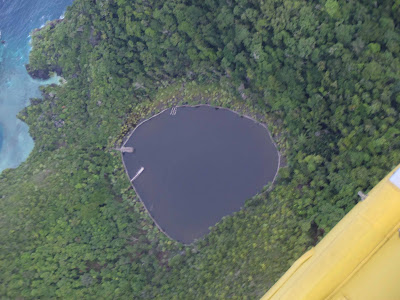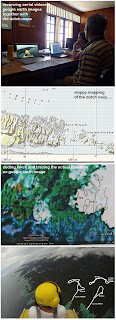Equipped with coordinates and distant aerial pictures, we never quite know what to expect when rounding the last corner before the estimated entry point of an unexplored lake. More often than not, after gliding over gorgeous shallow water coral reefs, our boat comes to a halt in front of a seemingly impenetrable wall of sharp limestone covered in thick rainforest. Undeterred, our trusted guides Jams, Ali and Hassan go out to scout the area first, machete in hand, to find out how realistic it is to access the lake, having gained a good impression of what we ladies are capable of. After anything from a few minutes to almost an hour, they suddenly resurface out of the jungle. The ensuing conversations usually consist of a variation on the following themes:
- “bisa?” “bisa!” (can? can!)
- “bisa?” “tidak bisa... too high!” (can? can’t... too steep!)
- “bisa?” “mungkin bisa. jau sekhali... setengah mati!!” (can? maybe can. very far... half dead!!)
- “bisa?” “bisa... tapi air tawar.” (can? can... but it’s fresh water.)
Once it has been established that a lake is accessible and marine, we start our ascent into the unknown. Each lake entry is a different adventure with its own character and challenges. Some come with muddy slopes or sharp lose rocks, others require advanced climbing skills, some make us feel like Tarzan’s Jane as we swing from one tree to the next, while others have us mildly worried about the diseases we might be exposing ourselves to while wading through smelly swamps.
But as the lakes come into view we are always rewarded with magical sceneries, each lake beautiful and peaceful yet unique. In some cases we are probably the very first people to set our eyes on a particular lake, and this knowledge raises a strange feeling, suddenly being struck again by how privileged we are to be out here.
Our scientific instincts soon take over, and we start scanning the edges to determine what type of fauna and flora dominate the lake. This includes critically examining every log-like object from a distance, and hoping that everyone agrees that it is “kayu” (wood) and not “buaya” (crocodile). Indeed, although we have been made aware of emergency procedures in the not completely unlikely event of a crocodile attack (they like hanging out in brackish waters), we would rather not find out whether we are any good at hitting a crocodile on the nose with a miniature rake, poking a dive knife into its eye or even safer hopping onto its back.
Once we are confident enough that the coast is clear, we slowly slide into the water in order not to stir up the sediment. Each of us will spend the next few hours completing their part of the lake survey, such as tracking its shape and dimensions, performing sponge community surveys or recording water parameters. More on this in another blog entry.
Lisa and Cat
















